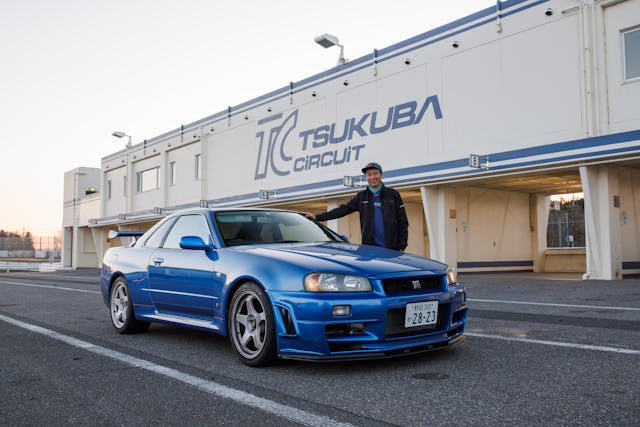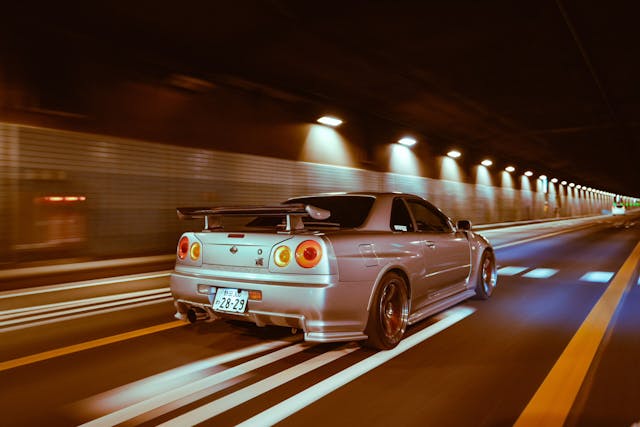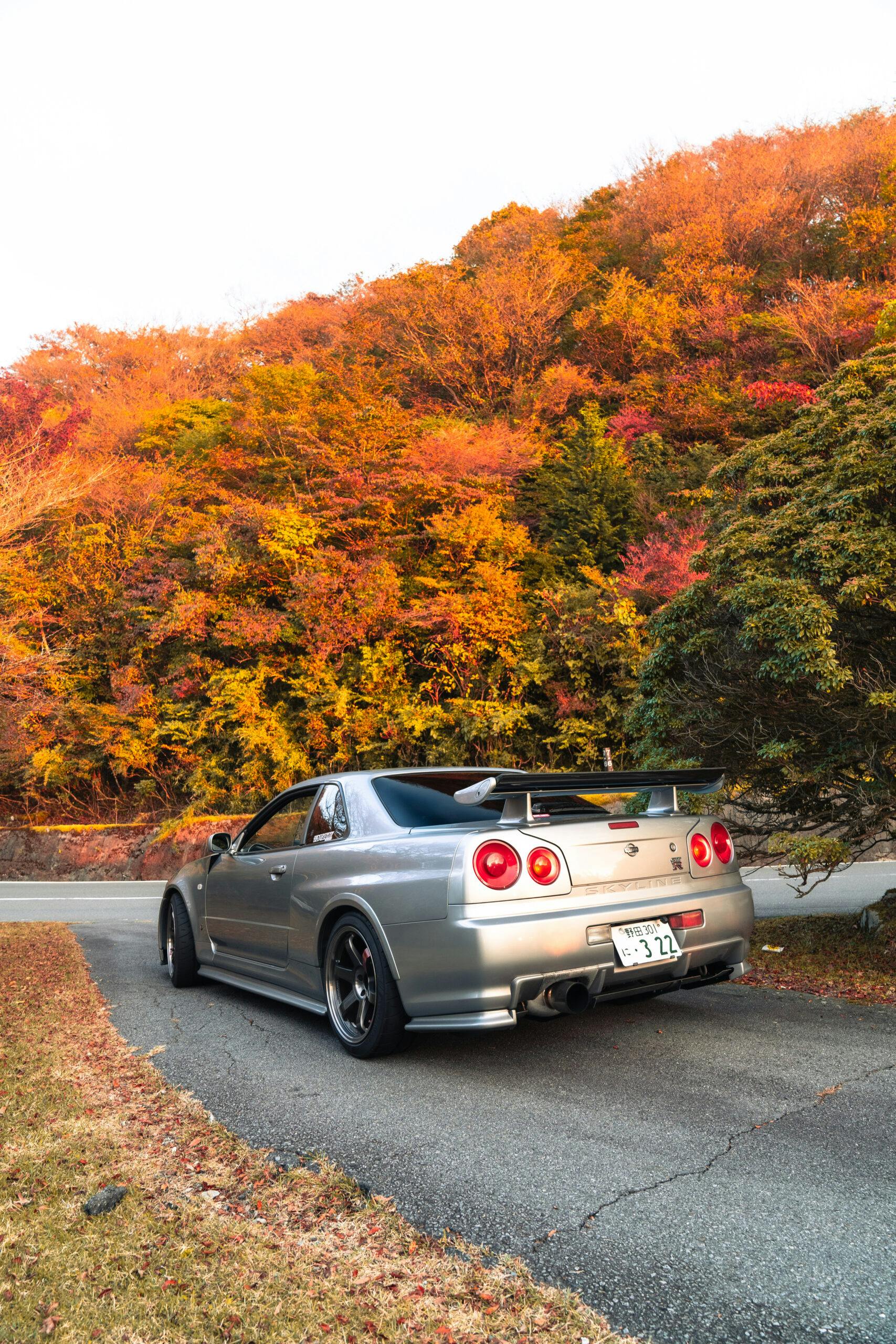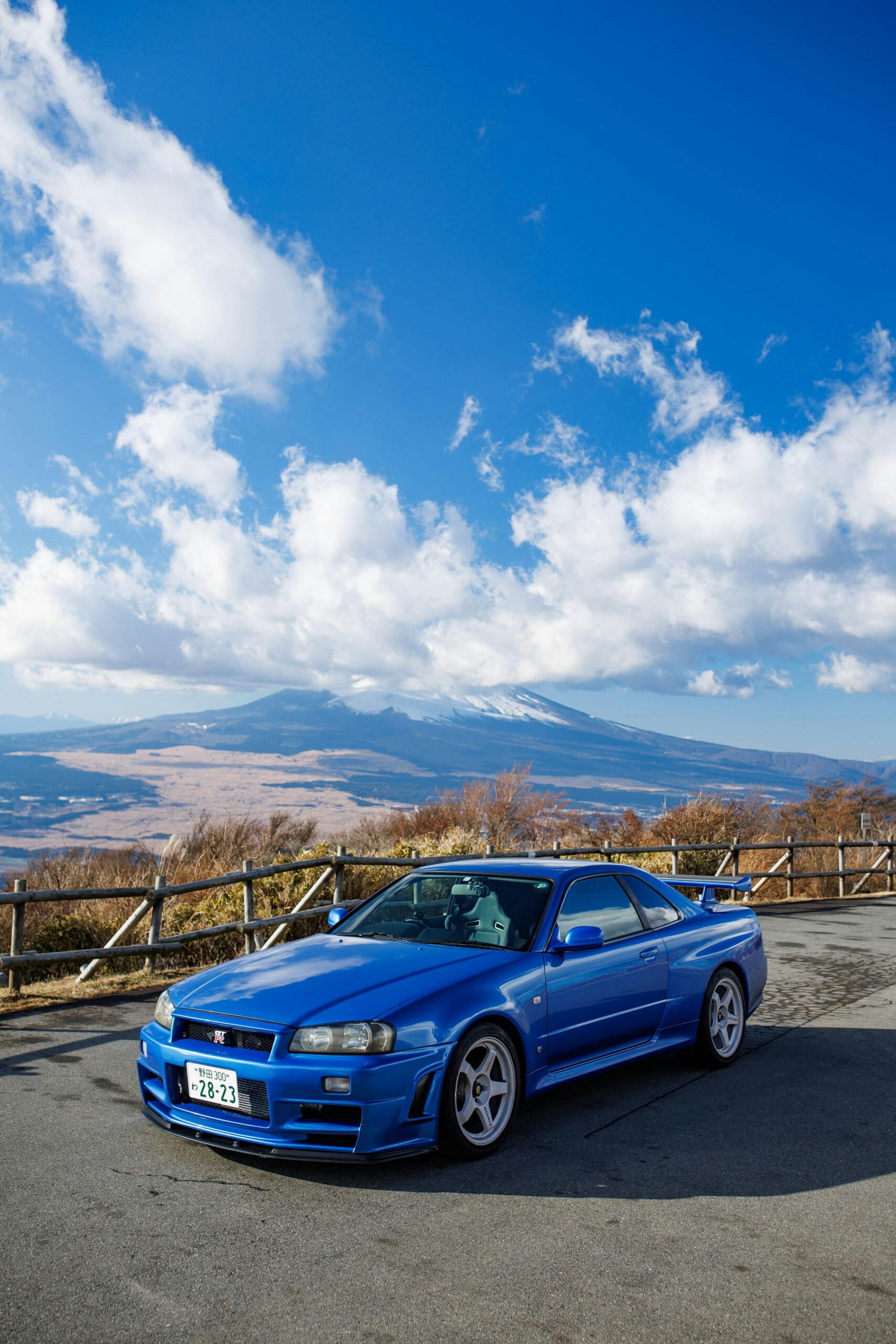Nissan’s red-hot R34 Skyline GT-R will soon invade the U.S. market
The Japanese collector-car market, on the rise as of late, is about to have a milestone year. 2024 brings with it the ability to import into the U.S. several lust-worthy enthusiast vehicles hailing from the class of 1999, but one car stands above the rest: Nissan’s R34 Skyline GT-R.
The hype surrounding the R34 GT-R is hard to understate, even if its story has become well-known. The new-for-’99 top-dog Skyline GT-R combined the utter racing dominance and tuner-car prowess of its R32- and R33-generation forebears with silver-screen and video-game fame to forge its place among the most revered JDM (Japanese domestic market) cars of all time. The U.S.’s 25-year import rule has only added to the desire and anticipation.

“For me, driving the R34 feels special, but more importantly, the car’s appeal is in its lore, the aura it emits, the look, the texture, the beauty, and the shape,” says photographer, enthusiast, and Hagerty video personality Larry Chen. “The R34 GT-R is pretty much the pinnacle of ’90s Japanese car culture, and it’s also the last of its kind.”
Chen fell for the R34 when he drove it in the Gran Turismo video game as a teenager, vowing that he’d one day have his own in Bayside Blue—the car’s launch color. For those not already familiar with his work, Chen has snapped some of the most memorable automotive images of the last couple decades and has immersed himself in the import tuner scene for even longer. As a result, he’s had plenty of time in and around the best cars Japan has to offer. Through all his experiences since then, his passion for the R34 never wavered.
Earlier this year he made good, purchasing an early-run ’99 R34. It’s still in Japan awaiting its 25th birthday to cross the Pacific, but in the meantime, Chen’s taken advantage of using the car on its home soil, racking up about 7000 km.
“As a Japanese car enthusiast and someone who grew up in the Gran Turismo era, there’s just nothing like driving your own car in Japan,” says Chen. “Every time I’m there, going down the highways and to the tracks I had only experienced on screen, or parking my car in a vending machine, I have to pinch myself. It doesn’t feel real because it’s so beyond what I could have ever imagined as a kid.”
Buying a car thousands of miles away a year or more ahead of its import eligibility takes some dedication, but Chen isn’t alone. Toprank Importers of Cypress, California, reports that the practice is becoming increasingly regular. In fact, for many, it’s part of the broader experience to which the R34 is essentially a ticket.
“A group of owners will fly to Japan, pick up their cars—which are registered there and stored in our facility—and will attend the Rs Meeting at Fuji Speedway, drive through the mountains, or hit Bayshore or other famous routes,” says Brian Jannusch, sales director at Toprank. “Some buyers have said, ‘I want to purchase a 2001 or 2002 GT-R, not because I don’t have the money to buy the ’99, but because I intentionally want to experience the car in Japan before I bring it back to the U.S. for the rest of my life.’”

Setting aside for a moment the healthy sense of community and activities that surround these cars, what is it about the R34 generation specifically that makes it so different and sought-after? It is, after all, the final step in an evolutionary, not revolutionary, path that began with the R32.
From a numbers perspective, the R34 is the rarest of the three, with 11,578 made according to GT-R Registry. R33s are next, with 16,668 produced, and the R32s are much more prevalent, with 43,937 hitting the streets.
This smaller number of cars is divided again by what’s perhaps the most varied submodel list of these three generations. A few familiar favorites like the V-Spec and N1 were reprised, but new to the menu were the more comfort-minded M-Spec as well as the Nür, which in a sense was a final edition attached to the V-Spec II and M-Spec.
As with the previous two generations, the R34 was motivated by the 2.6 liter RB26DETT engine, making the same 276 horsepower rolling through the proven ATTESA all-wheel-drive setup and HICAS 4-wheel steering. A Getrag V160 six-speed manual replaced the prior five-speed unit, the body received additional stiffening over the R33, and minor suspension tweaks that varied based on submodel were made as well.

Among its siblings, the R34 is the most visually aggressive, looking the most like a tuner car from the factory. That could be further amplified by NISMO factory body kits, which, along with a host of other NISMO tuning parts, remain available and very popular. Unlike earlier NISMO creations, R34-based cars were not born as such, rather they were customer cars sent to the Omori Factory for upgrade.
Like many Japanese cars from the era that are now collectible, modifications aren’t frowned upon, in large part due to the context in which Americans saw these cars a quarter-century ago. Along similar lines, “numbers matching” is not part of the buying process for GT-Rs. There’s a chassis plate on the firewall, but there’s no way to confirm the originality of the drivetrain. Finding a trustworthy inspector is essential to ensure you’re sourcing a good car, especially if you intend to buy it in Japan rather than after it’s imported to the U.S.
Which gets us to a critical part of the process: what year car to buy. Yes, the ’99 is the one that will be eligible soonest, but if you’re in the market for an R34 GT-R and you’ve been waiting for them to reach legal status, be prepared to shell out. That “buy a younger model year and enjoy it in Japan” strategy is more than a means to a touge run—it will also save you a few bucks.
The delta between a great ’99 R34 with a build date that enables it to be imported in January of ’24 and a 2000 or 2001 model that’s in the same condition with the same spec can be as much as $100,000. That’s just the delta—the price tag for that top-flight early car is about $240K. That said, Jannusch says there’s no shortage of folks willing to pay the premium to be among the first.
You read that right—unlike the R32, which was considered a legitimately affordable car at the beginning of its import eligibility in 2014, the R34 is straight-up expensive already. You’ll be hard-pressed to find a sorted R34 anywhere in the world for less than $100,000. And that’s with the smart money getting in early.
What’s next after R34s start to become legal for import on January 1, 2024? Realistically, it may be several months before we start seeing R34s on the streets and at events in any real numbers. There are a couple factors at play. First, the 25-year legal import status is determined by the year and month of manufacture. Second, transit takes time, as does the customs process. In addition, cars that are already here via the Show or Display rule will be easier to transact once they reach their 25-year build date.
We expect the market to evolve for these cars as the premium for immediately ready R34s works its way into the system. Right now, the market for an R34 GT-R ranges from expensive to downright eyewatering. To get your hands on a GT-R that literally needs nothing, be prepared to shell out at least $100,000, plus storage fees.
From there, the price tag creeps up dramatically. Cars already in the U.S. via Show or Display are by nature high-demand, limited-production variants. Models like the V-Spec finished in Midnight Purple II have sold in the states in excess of a quarter million and even more exclusive models such as the M-Spec Nür and N1 command high six-figure price tags, with rumors of upwards of seven-figures for the right cars with no kilometers in the clock. However, premiums commanded for Show or Display–imported and MotoRex cars have the potential to diminish as the rest of the market catches up.
Of course, if that isn’t expensive or exclusive enough for you, look no further than the cars upgraded by NISMO’s Omori Factory. These are bona-fide blue-chip collectors of the JDM world with cars like the coveted R34 Z-Tune commanding multiple millions of dollars. Based on the performance of Show or Display–eligible cars we track in the price guide, values shot up drastically in 2021 and 2022, but have since leveled out. That said, the realization by the broader JDM collecting community that we in the U.S. market can now have these may renew activity in this market.
If the R32 and R33 GT-R’s past value trends are any indication, don’t expect prices to go down with more supply stateside—the GT-R market is a global one, and there’s no shortage of demand. The GT-R retains an immense following across Asia and in Australia due to its racing success, and many countries, including those that use right-hand drive vehicles, have had the importation jump on the U.S. for years. Passionate buyers exceed available cars by a wide margin.
There’s likely to be a knock-on effect for the older-generation cars, too. Jannusch reports that he thought R32s would see a price drop when R33s became legal to import, but the increase in R33 values steered consumers to the more abundant, less expensive R32, which in turn made their values go up.

Unsurprisingly, the R34 is incredibly popular among millennials. Given that so few R34s are in the country at this point, it is hard to draw significant conclusions on buyer demographics. However, Hagerty quote data lines up with previous generations of GT-R, where millennials account for over half the insurance inquiries.
Chen affirms this notion: “I think the collectors that will buy them are primarily the ones that grew up in my generation that have done well for themselves and can justify buying the car of their dreams,” he says. “The GT-R is forbidden fruit, and you always want what you can’t have.”
Chen’s and Jannusch’s responses brimmed with talk of how their R34s connected them with people and places. If their experiences are indicative of who’s buying these cars, it’s a safe bet most R34s headed to the states will get the healthy use they deserve, and that’s a testament to what the R34 means to those in its community.
“The easiest way to sum this up for people that don’t follow the Japanese market is that Skyline GT-R people are just Porsche people from the Gran Turismo era,” says Jannusch. “They like the history, they like that the car has racing pedigree, and they especially like the culture that’s been built around it.”
If Jannusch’s characterization is accurate, the R34’s already red-hot future is poised to remain bright.
***
Check out the Hagerty Media homepage so you don’t miss a single story, or better yet, bookmark it. To get our best stories delivered right to your inbox, subscribe to our newsletters.





I don’t get it.
Maybe ’cause I’m not a video gamer.
One less buyer out there, then!
I think that it goes beyond video games. As the article points out, this is a car that is strongly favored by younger enthusiasts, especially Millennials and Gen Z (so early 40s and younger) who relate to them more. No different than their fathers favoring Big Block Mustangs, and Challengers and paying high dollars because of movies like Bullitt or Vanishing Point. Nostalgia is pretty facinating and how it relates to collecting.
What’s not to get? When I was a kid the only car i wanted was a 3rd gen Trans Am/Formula. All thanks to growing up watching Knight Rider. After owning a few of them over the years, I’ve come to realize they aren’t the best cars but I’ll always have a soft spot for them. Even though both my Kia Stinger awd gt & Ford Lightning would destroy any 3rd gen besides maybe the Turbo Trans Am & SLP Firehawk. I would still love to own those models, especially the rare SLP Formula Firehawk. Nostalgia baby!
I don’t see why there’s any question. They’re fast, rare (ish), and look good.
Good ol repeat articles!
I would want an R34 GT-R but they became six figure cars awhile ago. So I’m out.